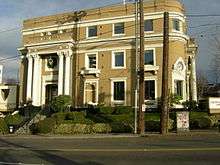Funeral home




A funeral home, funeral parlor or mortuary, is a business that provides interment and funeral services for the dead and their families. These services may include a prepared wake and funeral, and the provision of a chapel for the funeral.
Services
Funeral homes arrange services in accordance with the wishes of surviving friends and family, whether immediate next of kin or an executor so named in a legal will. The funeral home takes care of the necessary paperwork, permits, and other details, such as making arrangements with the cemetery, and providing obituaries to the news media. In recent years many funeral homes have started posting obituaries online and use materials submitted by families to create memorial websites.[1]
There are a few common types of services in North America. A traditional funeral service consists of a viewing (sometimes referred to as a visitation), a funeral service in a place of worship or the funeral home chapel and a graveside committal service. Direct cremation consists of the funeral home receiving the corpse, preparing it for the crematory and filing the necessary legal paperwork. Direct/immediate burial is the forgoing of a funeral ceremony for a prompt, simple burial. Moving a corpse between mortuaries involves preparing it for shipment in a coffin strapped into an arbitrary or a combination unit (mac pac / airtray). This is common when it is to be buried in a different locality than where the person died.
When a corpse is brought to a funeral home, it is sometimes embalmed to delay decomposition or to make the viewing of the body more pleasant. The procedure typically involves removing sufficient blood material to accommodate the preservative chemicals and dyes, aspirating the internal organs and setting the facial features. Cosmetics are used with the consent of the family to improve the appearance of face and hands for a more natural look. If the face or hands are disfigured by accident, illness or decomposition, the embalmer may utilize restorative techniques to make them presentable for an "open casket" service. If this isn't possible, or the family wishes, the funeral home can perform a "closed casket" service.
The funeral home often sets aside one or more large areas for people to gather at a visitation. This area may contain a space to display the body in a casket to visitors who may pay their respects. Funeral and memorial services may also take place at the funeral home. Many funeral homes offer prearrangement options for those who wish to plan their own funerals.
Several large multi-national corporations in this service field have received exposure from high-profile litigation.[2] The Loewen Group, Inc., received a particularly large jury verdict in the State of Mississippi which was later found to be in error as the allegations against Loewen Group proved false. The Canadian-based company then brought suit against the United States alleging violations under N.A.F.T.A..[2] Houston based Service Corporation International has also had their share of legal troubles with the operations of both their funeral home and cemetery operations.
See also
| Wikimedia Commons has media related to Funeral homes. |
References
- ↑ "6 Ways Funeral Homes are Using Integration to Save Time, Money & Get to the Next Level.". blog.frontrunnerpro.com.
- 1 2 [Dummer, Stephen W., Mississippi Judicial System: Failing to Meet the Minimum Standard of Justice in Loewen Group, Inc. v. O’Keefe, 6 GEO. J. L. & PUB. POL’Y 531 (2008).